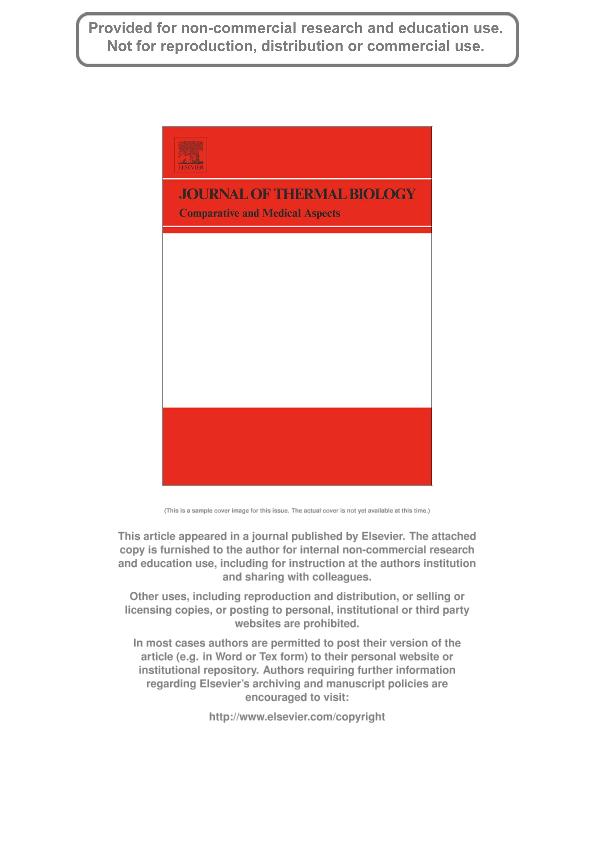Mostrar el registro sencillo del ítem
dc.contributor.author
Medina, Susana Marlin

dc.contributor.author
Scolaro, Jose Alejandro

dc.contributor.author
Méndez de la Cruz, Fausto Roberto

dc.contributor.author
Sinervo, Barry Raymond

dc.contributor.author
Miles, Donald Bailey

dc.contributor.author
Ibarguengoytía, Nora

dc.date.available
2018-12-13T19:48:01Z
dc.date.issued
2012-12
dc.identifier.citation
Medina, Susana Marlin; Scolaro, Jose Alejandro; Méndez de la Cruz, Fausto Roberto; Sinervo, Barry Raymond; Miles, Donald Bailey; et al.; Thermal biology of genus Liolaemus: A phylogenetic approach reveals advantages of the genus to survive climate change; Pergamon-Elsevier Science Ltd; Journal of Thermal Biology; 37; 8; 12-2012; 579-586
dc.identifier.issn
0306-4565
dc.identifier.uri
http://hdl.handle.net/11336/66462
dc.description.abstract
The trends of body temperatures in the field (Tb) and preferred body temperatures in the laboratory (Tpref) of the genus Liolaemus relative to reproductive mode, air temperature (Tair), precipitation, latitude, and elevation were studied using phylogenetic comparative analysis. Results were discussed in the framework of the evolution of thermal physiology and vulnerability to global climate change. Reproductive mode affects Tb but not Tpref. Whereas Tb and Tpref showed a significant association with Tair, there was no relationship with latitude or elevation. In most liolaemids, Tpref is significantly higher than Tair and Tb pointing to a primitive condition of Tpref, probably related to earlier Miocene environments. Phylogenetic trends in the evolution of liolaemid thermal physiology provide a physiological explanation for the lowest rates of observed contemporary climate-forced extinctions and those forecasted under climate warming scenarios up to 2080. Liolaemids have a much higher Tpref than is expected for their environments, especially for viviparous members of the genus, in contrast to other viviparous taxa in the sister family the Phrynosomatidae, which have evolved much lower Tb (and Tpref) and currently experience a much higher rate of climate-forced extinction.
dc.format
application/pdf
dc.language.iso
eng
dc.publisher
Pergamon-Elsevier Science Ltd

dc.rights
info:eu-repo/semantics/openAccess
dc.rights.uri
https://creativecommons.org/licenses/by-nc-sa/2.5/ar/
dc.subject
Liolaemus
dc.subject
Phylogeny
dc.subject
Squamata
dc.subject
Temperature
dc.subject
Viviparity
dc.subject.classification
Otras Ciencias Biológicas

dc.subject.classification
Ciencias Biológicas

dc.subject.classification
CIENCIAS NATURALES Y EXACTAS

dc.title
Thermal biology of genus Liolaemus: A phylogenetic approach reveals advantages of the genus to survive climate change
dc.type
info:eu-repo/semantics/article
dc.type
info:ar-repo/semantics/artículo
dc.type
info:eu-repo/semantics/publishedVersion
dc.date.updated
2018-12-05T14:35:51Z
dc.journal.volume
37
dc.journal.number
8
dc.journal.pagination
579-586
dc.journal.pais
Reino Unido

dc.journal.ciudad
Oxford
dc.description.fil
Fil: Medina, Susana Marlin. Consejo Nacional de Investigaciones Científicas y Técnicas; Argentina. Universidad Nacional de la Patagonia "San Juan Bosco". Facultad de Ciencias Naturales - Sede Esquel. Departamento de Biología; Argentina
dc.description.fil
Fil: Scolaro, Jose Alejandro. Consejo Nacional de Investigaciones Científicas y Técnicas. Centro Científico Tecnológico Conicet - Centro Nacional Patagónico; Argentina
dc.description.fil
Fil: Méndez de la Cruz, Fausto Roberto. Universidad Nacional Autónoma de México; México
dc.description.fil
Fil: Sinervo, Barry Raymond. University of California; Estados Unidos
dc.description.fil
Fil: Miles, Donald Bailey. Ohio University; Estados Unidos
dc.description.fil
Fil: Ibarguengoytía, Nora. Consejo Nacional de Investigaciones Científicas y Técnicas. Centro Científico Tecnológico Conicet - Patagonia Norte. Instituto de Investigaciones en Biodiversidad y Medioambiente. Universidad Nacional del Comahue. Centro Regional Universidad Bariloche. Instituto de Investigaciones en Biodiversidad y Medioambiente; Argentina. Universidad Nacional del Comahue. Centro Regional Universidad Bariloche. Departamento de Zoología; Argentina
dc.journal.title
Journal of Thermal Biology

dc.relation.alternativeid
info:eu-repo/semantics/altIdentifier/doi/https://doi.org/10.1016/j.jtherbio.2012.06.006
dc.relation.alternativeid
info:eu-repo/semantics/altIdentifier/url/https://www.sciencedirect.com/science/article/pii/S0306456512001088
Archivos asociados
